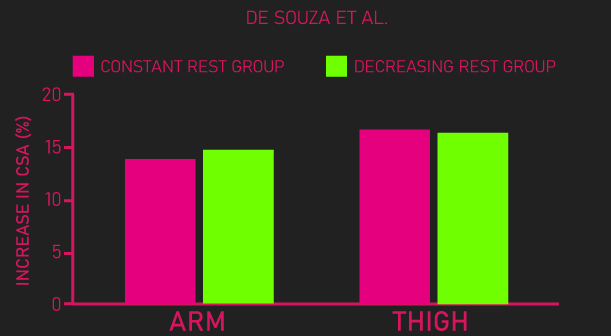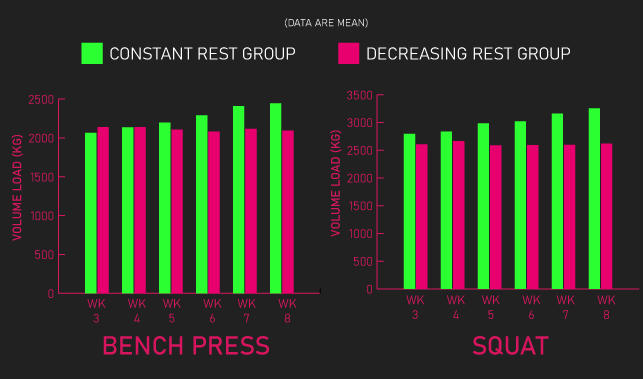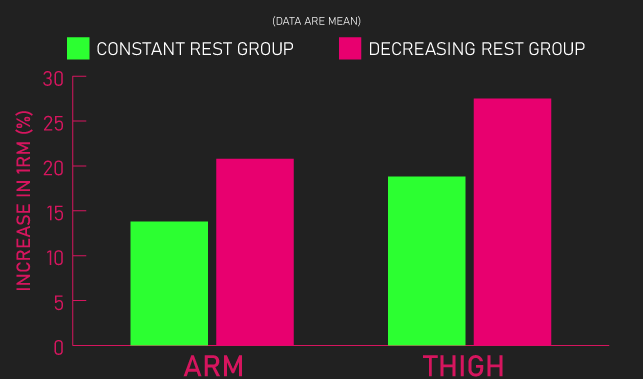
In a session, most people perform multiple sets on a given exercise, interspersed by a rest interval, typically lasting anywhere from 1 to 5 minutes. Most people also tend to hold their rest interval durations fairly constant from workout to workout.
Opposed to this, from workout to workout, an individual could gradually decrease their rest interval durations between sets.
How does this compare to using a constant rest interval duration every session for hypertrophy and strength? Is it better, worse, or no different?
Let us explore 2 studies by Souza Junior et al. addressing this. Then, we’ll examine the limitations and our conclusions with the current data.
The Research on Decreasing Rest Between Sets
Study One
The first study recruited 21 men with at least 1 year of training experience and assigned them into a constant or decreasing rest group.
For the first 2 weeks, both groups trained identically. They trained 6 times each week (the program is below) with each exercise performed for 3 sets with a 10-12 rep max load, using 2 minutes of rest between sets.

Thereafter, for the remaining 6 weeks, both groups continued to train 6 times per week but using a different program (shown below), with each exercise performed for 4 sets with an 8-10 rep-max load.

The constant rest group continued resting 2 minutes between their sets in a session, whereas the decreasing rest group, throughout the 6 weeks, gradually decreased their rest interval duration from 2 minutes to 30 seconds.

I should note that both groups adjusted their loads when necessary to ensure they kept performing 8-10 repetitions across their sets every session.
After the 8 weeks of training, there was no statistically significant difference in increases in squat and bench press one-rep max between the two groups.

Nor was there any statistically significant difference in thigh and arm cross-sectional area gains between the two groups.

Therefore, these results indicate gradually decreasing your rest interval duration across 6 weeks (from 2 minutes to 30 seconds) does not compromise hypertrophy or strength versus resting for 2 minutes between sets, but it was not any better either.
I want to bring your attention to another way we could think of these results.
Below are the volume loads (defined as the number of sets multiped by load) achieved on the bench press and squat exercise across the final 6 weeks of training.

The constant rest group continuously increased volume load on both these exercises over the 6 weeks. Now, given both groups performed 4 sets on each exercise, this data simply indicates this constant rest group managed to progressive overload via increasing the load they used within the 8-10 reps over the 6 weeks.
Conversely, the decreasing rest group saw minimal changes in volume load on both exercises over the 6 weeks. Again, given they performed 4 sets per exercise, this simply means they largely did not increase the load used on their sets as they decreased their rest intervals over the 6 weeks.
Another way to say all of this is that the constant rest group progressively overloaded via increasing the load they used, while the decreasing rest group progressively overloaded by decreasing their rest interval durations.
As both groups did not experience different strength or hypertrophy gains, this study possibly indicates progressively overloading via decreasing your rest interval durations is no less effective than progressively overloading via increasing the load you use.
Before moving on, if you’re curious about creating an effective training program for muscle hypertrophy, our high quality partner Alpha Progression can help. It can generate a highly effective program for you, track your workouts live with in-built progression recommendations, provide graphs displaying your long term progress, and it has a massive exercise database with more than 550 exercises.
Click HERE (the link opens in a new tab) to get a free 2 week trial of the apps features. If you like it and go beyond, the link also gives you 20% off a subscription!
We never promote trash at the House of Hypertrophy, so rest assured the app is high quality. The reviews speak to this, 4.8 starts (based on more than 7,000 reviews) on Google play, and 4.9 stars in Apple’s store (based on nearly 400 ratings).
Study Two
Let us move on to the second, similarly designed, study.
22 men with at least 1 year of training experience were assigned into a constant or decreasing rest group.
Both groups trained 6 times per week (the program is below) for 8 weeks, with each exercise performed for 4 sets with an 8-10 rep-max load.

The constant rest group used 2 minutes of rest between sets throughout the full 8 weeks.
The decreasing rest group rested for 2 minutes between sets for the first 2 weeks, and thereafter gradually decreased their rest interval duration each week until they rested 30 seconds between sets.

Like the last study, both groups adjusted their loads when necessary to ensure they kept performing 8-10 repetitions across their sets every session.
Unlike the last study, the researchers had both groups supplement creatine. All subjects in both groups loaded up during the first 7 days (consuming 20g of creatine ) and thereafter maintained a dosage of 5g of creatine until the end of the study.
After the 8 training weeks, there was no statistically significant difference in increases in squat and bench press one-rep max between the two groups.

Nor was there any statistically significant difference in thigh and arm cross-sectional area gains between the two groups. Having said this, the percentages do actually appear to favor the decreasing rest group.

However, given it was not statistically significant, we cannot be sure this percentage difference between groups truly reflects a difference. There were only 11 subjects per group, small sample sizes like this can compromise your ability to detect statistically significant changes, but they also introduce large variation in each group, such that these differences might just be a result of random chance.
On the account of this, I think the most accurate conclusion from this data is that gradually decreasing your rest interval duration (from 2 minutes to 30 seconds) across 8 weeks was no less effective than constantly resting 2 minutes between sets for strength and hypertrophy.
Now, in this study, volume load was defined as load multiplied by repetition number. However, given both groups performed 8-10 repetitions, any change in volume load should largely reflect changes in loads.
The constant rest group increased their volume load on the bench press and squat across the 8 training weeks, implying they progressively overloaded via increasing the loads used on their sets.

However, interestingly, the decreasing rest group actually saw a sharp decrease in bench press volume load during weeks 3 and 4, indicating a reduction in load was needed to maintain 8-10 reps per set as they gradually decreased their rest interval durations. Thereafter, they more stably maintained volume load, indicating they probably maintained similar set loads while continuing to decrease rest interval durations.
Volume load on the squat for the decreasing rest group was fairly stable across the 8 weeks, with slight reductions in the final weeks, largely indicating they maintained their set loads while decreasing their rest interval durations.
As a result, this study (like the last one) indicates progressively overloading via decreasing your rest interval durations (even if this somewhat necessitates a load reduction in some circumstances) is no less effective than progressively overloading via increasing set loads for hypertrophy and strength.
Limitations and Considerations
Integrating these two studies, it seems decreasing your rest interval durations is not inferior to using a constant rest interval duration.
Although, limitations and considerations exist.
The decreasing rest group was compared to a constant rest group resting 2 minutes between sets. However, is 2 minutes of rest between sets even optimal for hypertrophy and strength gains in the first place?
As thoroughly examined in our rest interval ultimate guide article, with compound exercises, resting for 2 minutes or more seems better for hypertrophy than shorter durations. With isolation exercises, the current data is conflicting in the optimal rest interval duration.
For strength, the current data indicates 2 minutes or more may be superior to shorter durations, at least for trained individuals.
However, is there actually a difference between resting for exactly 2 minutes or resting beyond this?
Ahtianen et al. found resting 2 minutes between sets produced similar quadriceps cross-sectional area increases compared to resting 5 minutes between sets. However, it’s worth noting subjects performed 1 extra set per exercise on average when resting 2 minutes between sets, potentially confounding things.
Willardson et al. found with all other training variables equal, resting 2 minutes between sets produced similar squat one-rep max gains compared to resting 4 minutes between sets.
Resultantly, the current limited existing evidence suggests the use of 2-minute rest intervals by the constant rep group in the studies might not actually be a limitation. But again, this is limited evidence, no other existing data (to my knowledge) helps us.
Another consideration is both studies lasted 8 weeks, what would happen over longer durations?
At least two possible questions stem from this.
First, what if after the 8 weeks, the decreasing rest group simply continued to rest 30 seconds between sets (as this itself is quite a short rest duration, shortening it further may not be that practical), over many months, would they still experience similar strength and hypertrophy gains?
Secondly, what if someone, over many months, kept switching back and forth between periods of only progressively overloading via decreasing rest interval durations and periods of maintaining a constant rest interval but overloading via increasing set loads? would this method still be as effective as exclusively using a constant rest interval duration between sets?
Finally, it’s worth remembering both the studies were conducted on trained men with an average age of roughly 20-22.
What about other individuals not in this demographic?
Overall, it would be awesome to see if future studies could replicate these studies, as well as perhaps address some of the limitations and considerations we noted. But for the time being, it seems that decreasing rest interval durations, at least in the short term, may be perfectly fine for hypertrophy and strength gains.
Remember to feel free to check out the Alpha Progression App if you’re interested. Also feel free to check out our free bench press e-book below.

